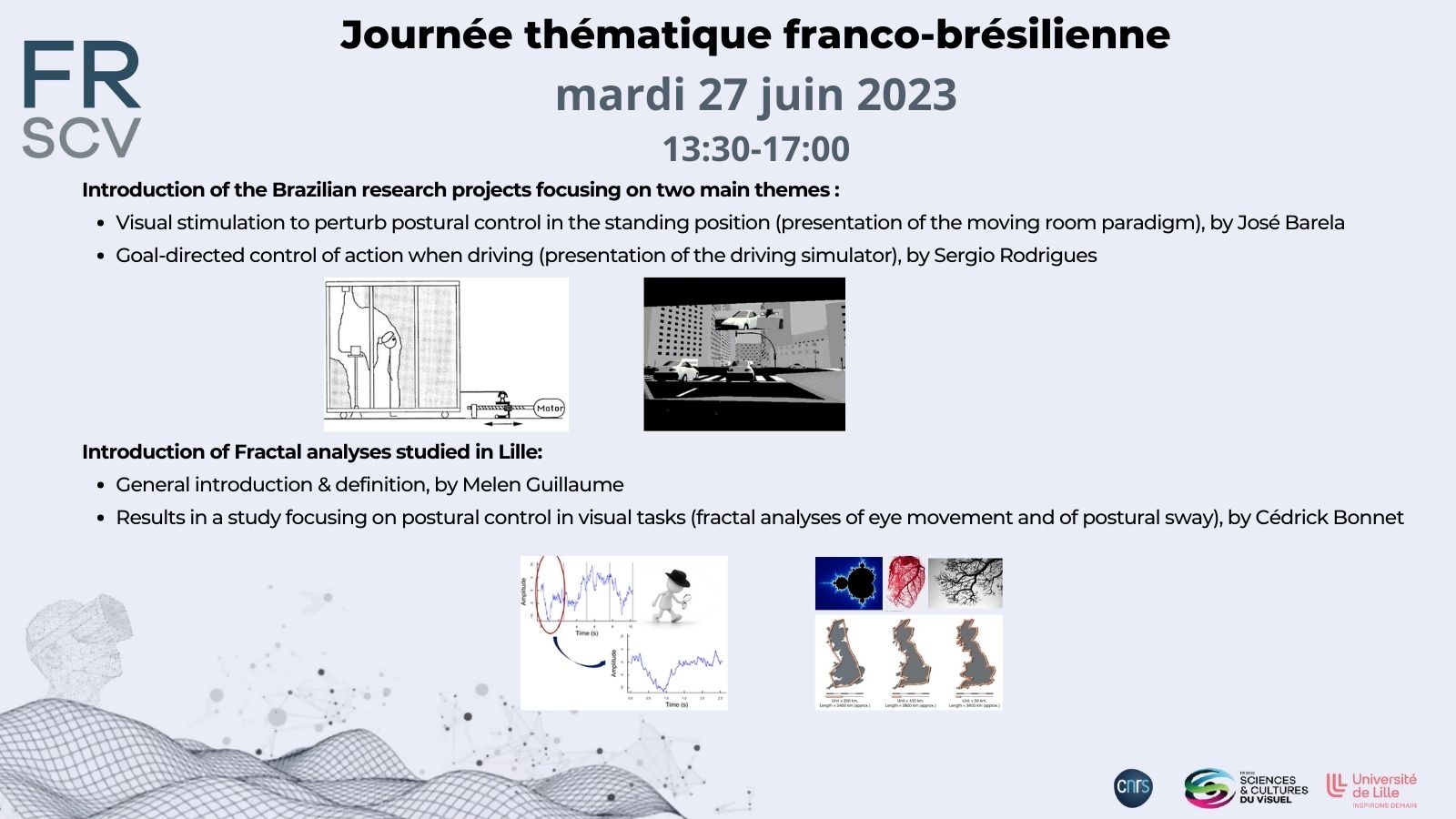Journée thématique franco-brésilienne
Brief introduction of 1 min of this “thematic day” (Cédrick Bonnet):
- Introduction of the Brazilian research projects focusing on two main themes:
- Visual stimulation to perturb postural control in the standing position (presentation of the moving room paradigm)
- Goal-directed control of action when driving (presentation of the driving simulator).
- Introduction of Fractal analyses studied in Lille: general definition and discussion of results in a study focusing on postural control in visual tasks (fractal analyses of eye movement and of postural sway)
Brazilian presentation (2 pm to 3 pm): Driving simulator and moving room paradigms: Coupling between sensory cues and motor performance
Sérgio T. Rodrigues
José A. Barela
Effective performance of any motor action requires the use of sensory cues about the environment and the relationship between the body and the environment. More interesting is that much of this relationship between sensory cues and motor performance occurs with little or any awareness of the performer and also in a predictive fashion, characterizing a perception-action coupling. In this presentation, we will detail the usage of a driving simulator and eye-head tracking paradigm to uncover strategies and procedures to measure gaze strategies and performance in different conditions. In addition, pupil dilation measurements are employed to examine attentional involvement and cognitive workload in all these simulations. Such approach will be explored and detailed. The coupling between sensory information (vision and touch) has also been examined through the moving room/touch paradigm. This is also a unique approach because, in our manipulations, the sensory cue characteristics (input) are controlled (i.e., amplitude, velocity – to avoid participant’s awareness) and from examining the participant’s response, several variables can be obtained (e.g., gain, coherence, variability). Moreover, because response occurs despite participants not being aware of sensory manipulation, we can examine the intrinsic dynamics of such sensory-motor coupling, revealing important issues of different populations (i.e., children, older adults, patients, among others) which may indicate relevant signatures of central nervous functioning.
Introduction to Fractal analyses (3 pm to 3:30 pm)
Mélen Guillaume
Cédrick Bonnet
Fractal analysis are nonlinear methods used to analyze the intrinsic nature of time-series. In the first part of the talk, we will define the concept (geometric fractality; temporal fractality; fractal dimensions) with illustrative examples from biomedical studies. By default, the environment around us has fractal properties and we will discuss/define how to study these properties (with monofractal and multifractal analyses). For example, monofractal analysis is a way to understand how variance changes as a function of the size of the time scales used to analyze the time series. Healthy behaviors are characterized by fractal properties and pathological conditions (e.g. Parkinson’s Disease) can impair fractal properties in many biomedical signals such as heartrate, center of pressure, EEG, walking, respiration (…). For these reasons, fractal analyses are relevant tools to study both healthy and unhealthy behaviors. In the second part of the talk, we will present results of a study conducted with healthy young adults standing and performing free-viewing exploration of large images. In this study, our objective was to analyze changes in fractal properties of movement related to the body (center of pressure, head) and to the eyes (eye displacements, pupil dilation) in challenging both the difficulty of balance and of the visual task. 21 healthy young adults stood upright in eight conditions combining four body positions and 2 modified visual Stroop tasks. We assumed that fractal properties of body movements and eye movements would be sensitive to changes in body position and the visual task, respectively. Our results validated these main hypotheses thus showing that fractal analyses may be system specific, at least when the systems are constrained all together.


Be First to Comment